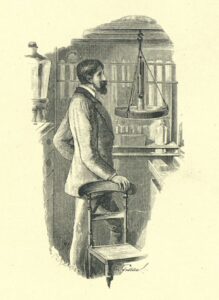The most comprehensive early study of the composition of seawater was that made by W.Dittmar (1884) on 77 samples collected by chemist J.Y.Buchanan during the Challenger Expedition(1872-1876). The physical and chemical investigations conducted by Mr.J.Y.Buchanan, during the three and half years’ cruise of H.M.S. Challenger, are among the most important and valuable of the Expedition. Mr.Buchanan collected daily, with much care, samples of the surface water, and determined the specific gravity. At all Stations, a slip water bottle was attached to the sounding line, and the specific gravity of the specimen of bottom water thus collected was also ascertained. At every Station, where practicable, waters were collected from intermediate depths at 25, 50, 100, 200, 300, 400, and 800 fathoms from the surface, with a stop-cock water bottle attached to a separate sounding line, under Mr. Buchanan’s personal supervision. The specific gravity of these waters was also determined. The routine chemical work of the Laboratory consisted in boiling out the gases from, and in determining the carbonic acid in, as many samples as possible. A very large number of samples of seawater were collected from the surface, bottom, and intermediate depths, and preserved in glass stoppered bottles.

These were either sent to home along with other collections from various ports touched at during the Expedition, or brought home by the ship.It is difficult to anyone, except those who actually witnessed the daily work at sea, to form an adequate idea of the labor, skill, and continuous effort required to carry these observations in all sorts of weather, and to form, and bring home successfully, collections and observations like those which have resulted from Mr. Buchanan’s exertions. Shortly after the return to England, Mr. Buchanan analyzed a number of the samples of gas which had been boiled out from the waters on board ship. As Mr.Buchanan was subsequently unable to proceed with the chemical work connected with the Expedition, the remainder of the gas samples (along with the results of those analyzed), the water samples, and Mr.Buchanan’s official journals, were entrusted by late sir C.Wyville Thomson to Professor W.Dittmar, F.R.S., with a request that he would undertake certain analyses of the gas samples and the waters. Professor Dittmar forwarded reports on his analyses at various times to the late Editor during the years 1878-81.

In the year 1882, Professor Dittmar undertook, at my request, to complete the gas and water analyses, and to prepare a Report on the whole of this investigations into the Composition of Ocean-Water, embracing the work done on board ship by Mr.Buchanan. ” John Murray, Editorial Notes to Report of the Scientific Results of the Voyage of HMS Challenger during the years 1873-76, Physics and Chemistry,V1.
With the exception of the early analysis as to the purity of a certain well-known soap, no results of an analytical laboratory have received more publicity and attention than the classical results obtained at the University of Edinburgh by Dittmar on the waters collected by J.Y.Buchanan. Since then many investigators have become interested in the chemistry of the sea.
“The importance of this result cannot be over emphasized, as upon it depends the validity of chlorinity-salinity-density relationship and, hence, the accuracy of all conclusions based on the distribution of density where the latter is determined by chemical or indirect physical methods, such as electrical conductivity…” Sverdrup, Johnson, Fleming








 Visit Today : 129
Visit Today : 129 Visit Yesterday : 204
Visit Yesterday : 204 This Month : 4486
This Month : 4486 Total Visit : 279494
Total Visit : 279494 Hits Today : 169
Hits Today : 169 Total Hits : 688239
Total Hits : 688239 Who's Online : 3
Who's Online : 3